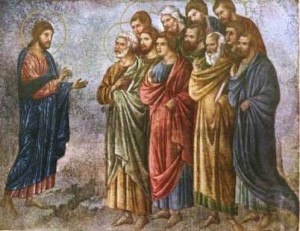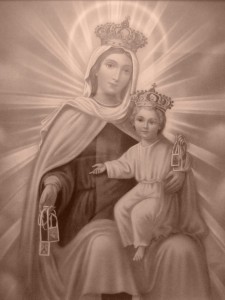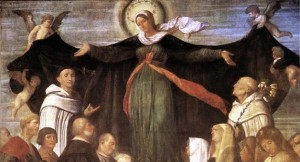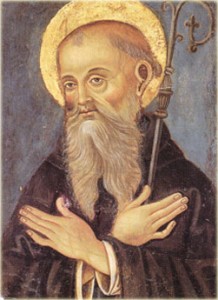On any number of occasions I’ve spoken about the various local commemorations of saints; not all liturgical calendars are the same due to the presence of locally venerated saints and blesseds. Saint Kateri Tekawitha is not on the liturgical calendar of Hong Kong, for example. A friend of mine brought to my attention an unusual feast, that of the Dispersion of the Apostles. It’s an Irish feast with no analogue in the USA. This is a clear example of the richness of local church. Moreover, one can say that the Catholic Church is not monolithic or hegemonic. Here’s the note of my friend:
 On July 15, Canon O’Hanlon notes the recording, in the Martyrology of Aengus, of The Feast of the Dispersion of the Apostles. This feast marks the dispersal of the Holy Apostles to their various missionary destinations, but in some of the copies of Saint Aengus’s calendar, a list of not only the biblical Twelve Apostles is appended, but also a list of the ‘Twelve Apostles of Ireland’. This was a name given to a group of early saints, students of Saint Finnian of Clonard, who themselves dispersed to various parts of Ireland to evangelise this country, some of them are also credited with founding missions outside of Ireland. In the account below I have transferred the actual quotations from the Martyrology out of the footnotes and into the main body of Canon O’Hanlon’s text. I have also added some notes on the identities of the Irish Twelve:
On July 15, Canon O’Hanlon notes the recording, in the Martyrology of Aengus, of The Feast of the Dispersion of the Apostles. This feast marks the dispersal of the Holy Apostles to their various missionary destinations, but in some of the copies of Saint Aengus’s calendar, a list of not only the biblical Twelve Apostles is appended, but also a list of the ‘Twelve Apostles of Ireland’. This was a name given to a group of early saints, students of Saint Finnian of Clonard, who themselves dispersed to various parts of Ireland to evangelise this country, some of them are also credited with founding missions outside of Ireland. In the account below I have transferred the actual quotations from the Martyrology out of the footnotes and into the main body of Canon O’Hanlon’s text. I have also added some notes on the identities of the Irish Twelve:
Festival of the Twelve Apostles
In the ancient Irish Church, on the 15th day of July, was celebrated the Festival of the Twelve Apostles, as we read in the “Feilire” of St. Aengus. In the “Leabhar Breac” copy is the following Irish rann, translated into English, by Whitley Stokes, LL.D.
“The twelve Apostles who excel every number, before a countless host Jesus distributed them among Adam’s seed.”
There is an Irish stanza annexed, in which those Twelve Apostles are severally named. Thus translated into English.
“Simon, Matthaeus and Matthew, Bartholomew, Thomas, Thaddaeus, Peter, Andrew, Philip, Paul, John and the two Jameses.”
And succeeding it, there is another, enumerating the Twelve Apostles of Ireland. This is headed “XII. Apostoli Hiberniae,” and then follow these lines, thus translated into English:
“The Twelve Apostles of Ireland”:
“Two Finnens, two chaste Colombs, Ciaran, Caindech, fair Comgall, Two Brenainns, Ruadan with splendour, Nindid, Mobii, son of Natfraech.”
This ancient Festival, styled the Separation of the Apostles of Christ for their Missions in various parts of the old world, has been often alluded to by the early Greek and Latin Fathers. The Bollandists, who place it at the 15th of July, have a learned disquisition on its origin and history, to which the reader is referred.
Notes on the Twelve Apostles of Ireland:
Two Finnens – the two great Saint Finnians – Finnian of Clonard, ‘tutor of the saints of Ireland’ and Finnian of Moville.
Two Chaste Colombs – Saint Columba of Iona and Saint Columba of Terryglass.
Ciaran – Some lists include two Ciarans, both Saint Ciaran the Elder (of Saighir) and Ciaran the Younger (of Clonmacnoise).
Caindech – Saint Canice or Kenneth of Kilkenny.
Fair Comgall – Saint Comgall of Bangor.
Two Brenainns – Saints Brendan the Elder (of Birr) and Brendan the Younger (the Navigator) of Clonfert.
Ruadan with splendour – Saint Ruadhan of Lorrha.
Nindid – Saint Ninnidh of Inismacsaint.
Mobii – Saint Mobhí of Glasnevin.
Son of Natfraech – Molaise of Devenish
Finally, it may be noted that the list of the Twelve Apostles of Ireland is preserved in various manuscripts which do not always tally. Some of the saints, not present on this list, can include Saints Senan and Sinell.
 Saint Apollinare of Ravenna was a third century saint from Antioch who was the first bishop and saint of Ravenna. It is recorded that his martyrdom happened on 23 July but the Church’s liturgical memorial is July 20.
Saint Apollinare of Ravenna was a third century saint from Antioch who was the first bishop and saint of Ravenna. It is recorded that his martyrdom happened on 23 July but the Church’s liturgical memorial is July 20.





